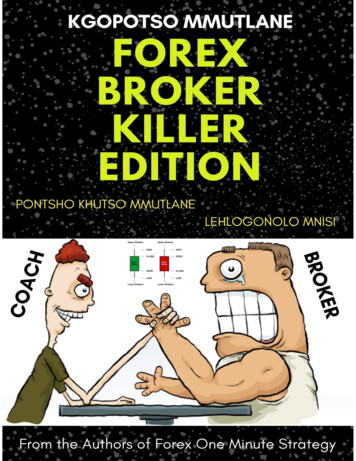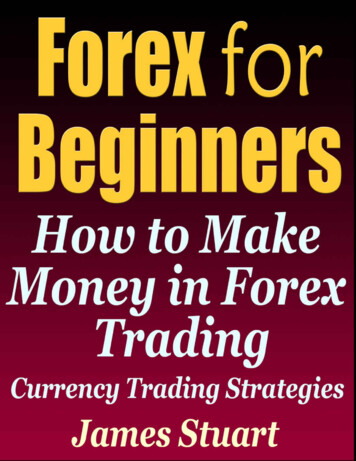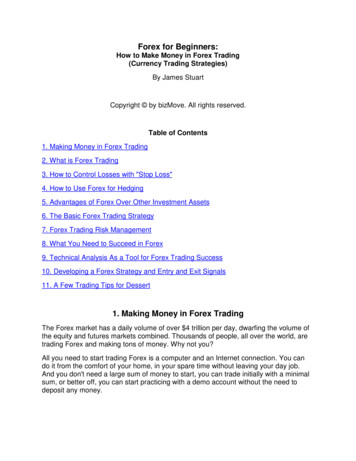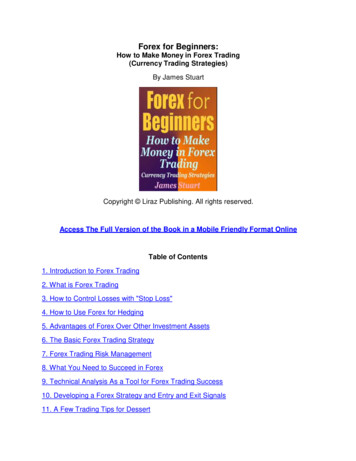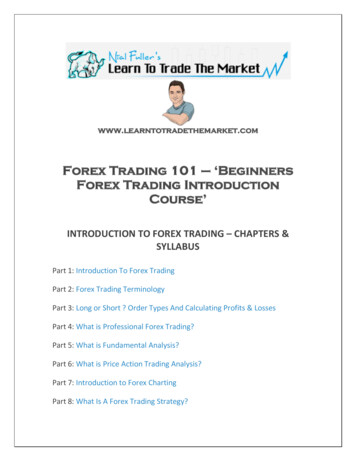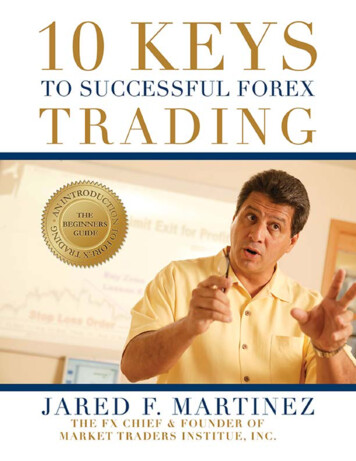
Transcription
Copyright 2014 www.swing-trading-strategies.comPage 1
TABLE OF CONTENTSCHAPTER 1:INTRODUCTION (Page 4)CHAPTER 2:WHAT IS PRICE ACTION? (Page 6)CHAPTER 3:MASS PSYCHOLOGY IN TRADING (Page 15)CHAPTER 4:PRICE CHART (Page 18)CHAPTER 5:TRENDS (Page 32)CHAPTER 6:REVERSALS AND CONTINUATION (Page 37)CHAPTER 7:UNDERSTANDING MARKET SWINGS (Page 40)CHAPTER 8:HOW TO TRADE SUPPORT AND RESISTANCE LEVELS (Page 44)CHAPTER 9:HOW TO TRADE CHANNELS (Page 49)CHAPTER 10:NINE (9) CHART PATTERNS EVERY TRADER NEEDS TO KNOW (Page 52)CHAPTER 11:NINE (9) CANDLESTICK PATTERNS EVERY TRADER NEEDS TO KNOW (Page 81)CHAPTER 12:HOW TO TRADE FIBONACCI WITH PRICE ACTION (Page 93)CHAPTER 13:HOW TO TRADE TRENDLINES WITH PRICE ACTION (Page 98)CHAPTER14:HOW TO TRADE MOVING AVERAGES WITH PRICE ACTION (Page 103)CHAPTER 15:HOW TO TRADE CONFLUENCE WITH PRICE ACTION ( Page 110)CHAPTER 16:WHY YOU SHOULD USE MULTI-TIMEFRAME ANALYSIS (Page 116)CHAPTER 17:TRADE THE OBVIOUS (Page 124)CHAPTER 18:CLOSING REMARKS (Page 127)Page 1
Page 2
DisclaimerTrading foreign exchange on margin carries a high level of risk and may not be suitable for all investors. The highdegree of leverage can work against you as well as for you. Before deciding to trade foreign exchange you shouldcarefully consider your investment objectives, level of experience, and risk appetite. The possibility exists that youcould sustain a loss of some or all of your initial investment and, therefore, you should not invest money youcannot afford to lose. You should be aware of all the risks associated with foreign exchange trading and seekadvice from an independent financial advisor if you have any doubts.OpinionsAny opinions, news, research, analyses, prices or other information contained on this ebook is provided as generalmarket commentary and does not constitute investment advice. www.swing-trading-strategies.com will not acceptliability for any loss or damage including, without limitation, to any loss of profit which may arise directly orindirectly from use of or reliance on such information.Accuracy of InformationThe content on this ebook is subject to change at any time without notice, and is provided for the sole purpose ofassisting traders to make independent investment decisions. www.swing-trading-strategies.com has takenreasonable measures to ensure the accuracy of the information on the ebook; however, it does not guaranteeaccuracy and will not accept liability for any loss or damage which may arise directly or indirectly from the contentof this ebook.Page 3
CHAPTER 1: INTRODUCTIONTo really understand price action means you need to study what happened in thepast. Then observe what is happening in the present and then predict where themarket will go next.“Regardless of what you may think, all traders are forecasters, just like theweatherman.”The weatherman knows where the wind is blowing from, sees the high and lowpressure systems forming over the land, knows the temperature variation, coldfront, hot front you know what I’m talking about, right? Then what does he do?He will say something like “tomorrow, the weather in Edinburg will be mostlycloudy, slight chance of shower and possibly sunny in the afternoon.”How does he know that?Copyright 2014 www.swing-trading-strategies.comPage 4
Well, from studying the past data and seeing what the current weather situationis at the moment (and these days, their prediction is more reliable due advancedcomputer models and weather satellites in space).So traders are like that If we get the direction wrong, we lose money, we get it right, we make money.Simple as that. So everything you are going to read here is about trying to get thatdirection right before you place a trade.Before you get started, these are some words that you may encounter:Long buyShort sellBulls buyersBears sellersBullish if the market is up, it is said to be bullish (uptrend).Bearish if the market is down, it’s said to be bearish.Bearish Candlestick a candlestick that has opened higher and closed lower is saidto be bearish.Bullish Candlestick a candlestick that has opened lower and closed higher is saidto be a bullish candlestick.Risk : Reward Ratio if you risk 50 in a trade to make 150 then your risk: rewardis 1:3 which simply means you made 3 times more than your risked. This is anexample of risk: reward ratio.Copyright 2014 www.swing-trading-strategies.comPage 5
CHAPTER 2: WHAT IS PRICE ACTION?This is the basic definition of price action trading:When traders make trading decisions based on repeated price patterns that onceformed, they indicate to the trader what direction the market is most likely tomove.Price action trading uses tools like charts patterns, candlestick patterns,trendlines, price bands, market swing structure like upswings and downswings,support and resistance levels, consolidations, Fibonacci retracement levels, pivotsetc.Generally, price action traders tend to ignore the fundamental analysis-theunderlying factor that moves the markets. Why? Because they believe everythingis already discounted for in the market price.But there’s one thing I believe you should not ignore: major economic newsannouncements like the Interest Rate decisions, Non-Farm Payroll, FOMC etc.From my own experience and from what I’ve seen, I say this “the release ofeconomic news can be both a friend and an enemy for your trades.”Here’s what I mean by that: If you did take a trade in line with the result of economic news release youstand to make a lot more money very quickly in a very short time becausethe release of the news often tends to move price very quickly either up ordown due to increased volatility. But if your trade was against the news, you can walk away with all yourprofits wiped out or a loss and the loss can be huge because markets canmove so fast during that period that there’s also the chance that your stoploss cannot be triggered.Copyright 2014 www.swing-trading-strategies.comPage 6
The chart below shows and example of what can happen when there is majorforex fundamental news release:This is one experience I will never forget. I traded a perfect price action setup, thetrade went as I anticipated but a few minutes later, the market dropped downvery quickly.My stop loss was never triggered at the price level where I set initially.I tried to close that trade as many times as I could but it was impossible to closebecause the price was way down below where my stop loss price was! Pricejumped my stop loss.Copyright 2014 www.swing-trading-strategies.comPage 7
I just stood there and watched helplessly. After what seemed like an eternity, thetrade was closed by broker at the worst possible price way-way-way- downbelow!That single trade nearly wiped out my trading account. Instead of losing 2% of mytrading account, I lost almost half of it. I did not understand and did not knowwhat happened that night to make the market move like that. I could not sleepthat night.Later I found out that it was a major economic news release that moved themarket like that.Now before I place a trade, I head over to this website here to check the newscalendar: http://www.forexfactory.com/calendar.phpIf there’s a valid trade setup but If I see that the time is close to a major news tobe announced, I will not enter. There are exceptions where I will take a trade if Isee that I can place my stop loss behind a major support or resistance level.The high impact news are colour coded in Red. That’s what you look for(see figurebelow):Copyright 2014 www.swing-trading-strategies.comPage 8
Here’s what you can do:1. If a valid trade setup happening, check with forexfactory.com to make surethere are no major news announcements to be made soon that can impactyour trade.2. If there’s news to be released you can do these 2 things: don’t trade untilafter the news release and wait until markets starts trading normally again,or if you decide to trade, trade small contracts because the market is veryvolatile when the news is released. This can works for you or against you.You need to know what you are doing during these times.3. If you already have a trade that has been running (prior to the news releasetime) for some time and in profit, think about moving stop loss tighter ortaking some profits off that table in case the market goes against you oncethe news is released. In an ideal case, you would have taken this trade awhile ago and that the current market price is far away from your tradeentry price and you would have locked some profits already and if themarket moves in the direction of your trade after the news release, you willmake a lot of money.Copyright 2014 www.swing-trading-strategies.comPage 9
3 Important Reasons Why You Should Be Trading Price Action1. Price action represents collective human behaviour. Human behaviour inthe market creates some specific patterns on the charts. So price actiontrading is really about understanding the psychology of the market usingthose patterns. That’s why you see price hits support levels and bouncesback up. That’s why you see price hits resistance levels and heads down.Why? Because of collective human reaction!2. Price action gives structure to the forex market. You can’t predict with100% accuracy where the market will go next. However with price action,you can, to an extent predict where the market can potentially go. This isbecause price action brings structure. So if you know the structure, you canreduce the uncertainty to some extent and predict with some degree ofcertainty where the market will go next.3. Price Action helps reduce noise and false signals. If you are trading withstochastic or CCI indicators etc, they tend to give too false signals. This isalso the case with many other indicators. Price action helps to reduce thesekinds of false signals. Price action is not immune to false signals but it is amuch better option than using other indicators which are essentiallyderived from the raw price data anyway. Price action also helps to reduce“noise”. What is noise? Market noise is simply all the price data thatdistorts the picture of the underlying trend this is mostly due to small pricecorrections as well as volatility.One of the best ways to minimize market noise is to trade from larger timeframesinstead of trading from smaller timeframes. See the 2 charts below to see what Imean:Copyright 2014 www.swing-trading-strategies.comPage 10
And now, compare market noise in the 4hr chart (notice the white box on thechart? That equates to the area of the 5min chart above!):Smaller timeframes tend to have too much noise and many traders get losttrading in smaller timeframes because they do not understand that the big trendin the larger timeframe is the one that actually drives what happens in the smallertimeframes.Copyright 2014 www.swing-trading-strategies.comPage 11
But having said that, I do trade in smaller timeframes by using trading setups thathappen in larger timeframes. I do this to get in at a better price point and keepmy stop loss tight.This is called multi-timeframe trading and I will also cover this on Chapter 16 toshow you exactly how it’s done.Is Price Action Applicable To Any Other Market?The answer is yes. All the price action trading stuff described here are applicableto all markets.In here, I will be mostly be talking in terms of using price action in the currencymarket but as I’ve mentioned, the concepts are universal and can be applied toany financial market.Price Action Trading Allows You To Trade With An EdgePrice Action Trading is about trading with an edge. What is a trading edge?Copyright 2014 www.swing-trading-strategies.comPage 12
Well, put simply it means you need to trade when the odds are in your favour.Things like: Trading with the trend Trading With Price Action Using reliable chart patterns and candlestickpatterns. Trading using Support and resistance levels. Making your winners larger than your losing trades Trading only in larger timeframes Waiting patiently for the right trade setups and not chasing trades.All these kinds of things above helps you to trade with an edge. They may not beexiting and probably you’ve heard of these before but hey this stuff is whatseparates winners from losers.What Price Action Trading Is Not Price action trading will not makeyou rich but price action tradingwith proper risk management canmake you a profitable trader. Someof you will go through this guide andlearn and make much money butsome of you will fail. That’s just theway life is. Price action trading is not the holygrail but it sure does beat usingother indicators (most of whichoften lag and a derived from priceaction anyway!). Price action trading will not makeyou an overnight success. You need to put in the hard yards, observe andCopyright 2014 www.swing-trading-strategies.comPage 13
see how price reacts and see those repetitive patterns and then have theconfidence to trade them then you will be rewarded for that.If you are one of those that are going to learn from this course and apply it toyour forex trading, my hats off to you and I say “go and succeed.”Chart timeYou need chart time to understand Price Action. For some of you, it may take awhile for you to understand, while some of you may be very quick to learn.Observe the price action of the market. Go back to the past and see how themarket had behaved. What caused it to behave that way? You cannot be aconfident price action trader until you do this.If you could simply read the charts well enough to be able to enter at the exacttimes when the move would take off and not come back, then you would have ahuge advantage.Trend lines, specific candlestick patterns, specific chart patterns, Fibonacciretracement levels & support and resistance levels these are the tools I use totrade.If you put the time and effort into learning them, it won’t be long before you willbegin to understand and see how all these things fit together.Start learning to trade naked price action.Copyright 2014 www.swing-trading-strategies.comPage 14
CHAPTER 3: MASS PSYCHOLOGY IN TRADINGHere’s one thing about price action: it represents a collective human behaviour ormass psychology.Let me explain.All human beings have evolved to respond to certain situations in certain ways.And you can see this happen in the trading world as well:The way multitude of traders think and react form patterns repetitive pricepatterns that one can see and then predict with a certain degree of accuracywhere the market will most likely go once that particular pattern is formed.Copyright 2014 www.swing-trading-strategies.comPage 15
For example, if you see a major resistance level, price hits the level and forms a‘shooting star’ a bearish reversal candlestick pattern. You can then say with agreater degree of confidence that Price is going to head down.Why?Because there are so many trader watching that resistance level and they all knowthat price has been rejected from this level on a previous one or two occasions andthat tells them that it is a resistance level and that they can also see that bearishreversal candlestick formation and guess what they will be waiting to do?1. They will be waiting with their sell orders not just one sell order butthousands of them, some small and some big orders.2. But on the other side of the coin is that trader that have bought at a lowprice and now that the price is heading up to the resistance level, that’swhere most of their take profit levels are. So once they take their profitsaround resistance levels, that means there are now less buyers now andmore sellers. The balance tips in the direction of the sellers and that’s howthe price is pushed back down from a resistance level.Because price action is a representation of mass psychology the markets aremoved by the activities of traders.So price action trading is about understanding the psychology of the market usingthose patterns and making a profit as a result.There are 2 types of price action trading, the 100% Pure price action trading andthe not-so-pure price Action trading. Let me explain Pure Price Action TradingPure price action trading simply means 100% price action trading. No indicatorsexcept price action alone.Copyright 2014 www.swing-trading-strategies.comPage 16
Not-So-Pure Price Action TradingThis is when price action trading is used with other indicators and these otherindicators form part of the price action trading system. These indicators can betrend indicators like moving averages or oscillators like stochastic indicator andCCI. (Please don’t go googling CCI and stochastic indicators!)Origin of Price Action TradingCharles Dow is the guy credited to be the father of technical analysis. He came upwith the DOW Theory.The theory tries to explain market behaviour and focuses on market trends. Onepart of the theory is that the market price discounts everything. Therefore,technical analysts use price charts and chart patterns to study market and don’treally care about the fundament aspects of what move the markets.I will cover this a little bit later when I talk about what are trends, how trendsbegin (or end) in Chapter 5.Copyright 2014 www.swing-trading-strategies.comPage 17
CHAPTER 4: PRICE AND CHARTSNow, let’s study price in a little bit more detail this stuff is for thenewbies please skip this section if you think you know!What is price?Price is value given to a particular instrument usually in monetary terms and itsvalue is dependent on supply and demand. If the demand is more, price increases as more traders start buying anddriving prices up. Demand zones on your price charts are around support levels, that’s wherebuyers come and start buying and driving prices up! If there is an oversupply, price falls as there are more seller and less buyers.Copyright 2014 www.swing-trading-strategies.comPage 18
Supply zones on your charts are on and around resistance levels wheresellers come in and drive the prices down due the fact that there are veryfew buyers.Every time you open up your charts, all you are seeing are the forces of supplyand demand at work!If the market is going up, what does that tell you about the demand and supplythen? It means there’s a lot of demand for that instrument.Or what if the marketing is going down then what does that tell you about thedemand and supply then? There’s a less demand and lots of supply.But there’s something else about price it has a time component.So the price of something today will not be the same tomorrow or in a month orin a year. Supply and demand over time drives up and down the price.But how do you represent the value of price over time which in turn tells you ofthe supply and demand forces?Answer: You need price bars, candlestick and line charts. These are graphical andvisual representation of price over time, thus telling you a story about supply anddemand forces over a certain time period which can be 1minute up to one monthor year.Bar, Candlestick and Line ChartsPrice over a period of time is graphically represented in 3 main ways:1. The bar chart (as shown below).Copyright 2014 www.swing-trading-strategies.comPage 19
The bar char chart is simply looks like a “stick” or bar with 2 short knobs on bothsides. The knob on the left is the opening price and the knob on the right is theclosing price.Then there’s the wick on the upper end and the lower end. The highest point orlevel of the wick on the upper end is the highest price that was reached during acertain timeframe or period and the lowest point of the lower wick is the lowestprice that was reached also during the same time frame or period.2. The candlestick chart shown below conveys the same information as in thebar chart above:Copyright 2014 www.swing-trading-strategies.comPage 20
A candlestick chart to put it in another way is like putting a body over a skeletonof the bar chart!That’s the only difference between the bar chart and the candlestick chart is thatthe candlestick chart has a body and the bar chart does not.Copyright 2014 www.swing-trading-strategies.comPage 21
The red colour is most often used to indicate a bearish candlestick which meansthe price opened up high and closed lower. A green candlestick represents abullish candlestick and is the exact opposite.3. The Line Chart (As shown below) conveys the same price information overtime but does not reveal everything.The line chart is one of the least favourite of charts for trading. A line chart issimply drawn by connecting either the closing, high or low price and that’s howyou get the line on a chart.Line charts can be useful for looking at the “bigger picture” and finding long termtrends but they simply cannot offer up the kind of information contained in acandlesticks chart.Out of these 3, the candlestick chart is the most popular followed by the barchart. So from here on, I will be only focused on candlestick chart only but I mayend up using the word bar to refer to candlestick pattern as well so just be awareof that.Copyright 2014 www.swing-trading-strategies.comPage 22
I will talk more about the candlestick (and candlestick charts) as this is the breadand butter for price action traders.The candlestick The candlestick chart had its origins in Japan and can also be referred to asthe Japanese candlestick chart. The colour of the candlestick chart tells you if price was up or down in aparticular timeframe which means that candlesticks are either bullish orbearish candlesticks.Now most traders prefer to set green candlesticks as bullish and red candlesticksas bearish. And I like it to be that way for me personally. Some broker’s trading platforms have options where you can change thecolours of the candlesticks to any colour you want. If you are a woman, youmay change a bullish candlestick to pink! And bearish candlestick toPurple! (I have never seen a pink and purple candlestick yet).This candlestick shown below is an example of bullish candlestick.Copyright 2014 www.swing-trading-strategies.comPage 23
A Bullish candlestick simply means the price opened lower and closed uphigher after a certain time period, which can be 1minute, 5minute, 1hr or 1day etc. The candle body represents the distance price has moved from the openingprice to the closing price. The longer the body, means price has moved agreat deal upward after opening. The shorter the candle body means theexact opposite. The high is the highest price that was reached during that time period. The low is the lowest price that was reached during that time period.All these candlesticks shown below are bullish candlesticks which mean that theiropening prices was lower than the closing prices and therefore reflect and overalluptrend in the timeframe each candlestick was formed.Now, the candlestick shown below is an example of a bearish candlestick.A bearish candlestick simply means that the candlestick opened up at a highprice and closed lower after a certain time period.Copyright 2014 www.swing-trading-strategies.comPage 24
All these candlesticks shown below are bearish candlesticks meaning that theopening price was higher than the closing price, therefore reflecting a downtrend.Understanding Buying and Selling Pressure on CandlesticksDid you know that there are bullish candlesticks that are considered bearish andbearish candlesticks that are considered bullish? To really understand thisconcept, you need to understand buying and selling pressure.You see, every candlestick that is formed tells you a story about the battlebetween the bulls and the bears-who dominated the battle, who won at the end,who is weakening etc. All that is reflected in any candlestick you see. The lengthof the body of the candlestick as well as the shadow (or wick) tells you a storyabout the buying and selling pressure.Copyright 2014 www.swing-trading-strategies.comPage 25
For example, look at the two charts below:Look at the first green candlestick on the left chart, it’s a bullish candlestick right?Yes. But you can see that it has a very short body and very long wick (tail).It tells you the sellers (bears) were dominant. If this candlestick was to form afterhitting a resistance level, it will be considered a bearish signal even though it’s abullish candlestick.Now, you can apply the same sort of logic to all the other candlesticks above andread the story each one is telling you. If the upper wick is very long, it simple tells you that there’s a lot of sellingpressure. It means price opened and got pushed higher by the buyers butthen at the highest price, sellers got in and drove it back down. If the lower wick is long, it tells you that there’s a lot of buying pressure.Sellers drove the price down but buyers got in and drove the price back up. If the lower wick is short, it tells your there’s very minimal buying pressure. If the upper wick is short, it tells you that there’s very minimal sellingpressure.What about the length of the body of candlesticks? The longer the body of the candle indicates very strong buying or sellingpressure.Copyright 2014 www.swing-trading-strategies.comPage 26
A short body of a candlestick indicates little price movement and thereforeless buying or selling pressure. Sometimes the candles will have no upper or lower shadows but with verylong bodies. These are interpreted the same way as standard candlesticksbut are an even stronger indication of bullish or negative market sentiment. In the case of bullish candle, prices never decline below the open. In thecase of bearish candle, price never trade above the open. See below:Copyright 2014 www.swing-trading-strategies.comPage 27
Now, so far we have looked at individual candlesticks what if you combine morethan one candlesticks? What does it show you? Well, one important thing that group of candlestick can show you is howstrong or weak a bullish or bearish move is. They can also tell you if the bullish or bearish move is weakening. The word used to describe such a situation is momentum.The chart below shows 3 bearish candlesticks in a downtrend, each withdecreasing length and body lengths. Ina downtrend situation, when you seesuch happening, it is one signal the thatdownward trend is weakening. And ifthis happens around support levels, youshould sit up and take notice and alsowatch for bullish reversal candlestickswhich will give you the confidence tobuy!The following chart below shows you an example of decreasing downwardmomentum as price nears a support levels. What you will see is that the priorcandlesticks will tend to be longer and as price nears the support level, thecandlesticks starts to get shorter:Copyright 2014 www.swing-trading-strategies.comPage 28
This next chart below shows 3 bullish candles in an uptrend each with decreasinglengths. In an uptrend, when you see such happening around resistance levels, youshould take notice. Also watch for bearish reversal candlestick patterns to form.This will give you the confidence to sell.Copyright 2014 www.swing-trading-strategies.comPage 29
Here is an example of a bullish momentum decreasing in an uptrend and thenprice tumbles right after that :Notice (on the chart above) how the bullish candlesticks had increasing lengthsand then gradually decreased as the price went up then followed by a bigdownward fall/move?That’s price momentum. Every time you look at your charts, you need to beaware of such. Very important!Candlestick WicksThe wicks of candlesticks along with the body tell a story. A wick which can becalled a shadow or tail of a candlestick is a line situated above and below the bodyof the candlestick.Copyright 2014 www.swing-trading-strategies.comPage 30
How are candle wicks (tails/shadows) formed and what do they mean? Well, they are formed because of a change in market sentiment. For an upper wick, price is moving up and then market perception ischanged by traders and then price is pushed down towards the open bysellers. That’s how the upper shadow is formed. For the lower shadow, price is moving down but the market sentimentchanges and price is pushed up towards the close buy the bulls. That’s howa lower wick or shadow is formed.Longer wicks indicate increase change in market sentiment.What is the Significance of Candlestick Wicks? Candlestick wicks with long upper shadows commonly occur when anuptrend is losing strength. Long lower shadows occur when the downtrend is losing steam.Copyright 2014 www.swing-trading-strategies.comPage 31
CHAPTER 5: TRENDSWhen you have price moving across time due to supply and demand, then thiscreates trends. This section is a discussion about trends, how they form and howmany types of trends and what kind of structure trends have.It is important for you to understand the structure of trends so you will notdepend on any indicator to tell you if the trend is up or down becauseunderstanding what a trend is, the structure of a trend, what signals to look to tellyou that a new trend may be starting and previous one ending is one keyknowledge you require as a price action trader.And you only need to use price action to tell you if a trend is up, down orsideways.As I’ve mentioned above, there are 3 types of trends. In simple terms, a trend iswhen price is either moving up, down or sideways. So when price is moving up, it’s called an uptrend. When price is moving down, it’s called downtrend. When price is moving sideways, it’s called and sideways trend.Now each of these 3 trend types have certain price structure about them thattells you whether the market is in an uptrend, downtrend or sideways trend.These structures are derived from the Dow Theory. But I will explain it in herebriefly.Copyright 2014 www.swing-trading-strategies.comPage 32
The Dow Theory Of Trends SummarizedThe theory in simple terms says that:1. when price is in an uptrend, prices will be
3 Important Reasons Why You Should Be Trading Price Action 1. Price action represents collective human behaviour. Human behaviour in the market creates some specific patterns on the charts. So price action trading is really about understanding the psychology of the market using those patterns. That's why you see price hits support levels and .


